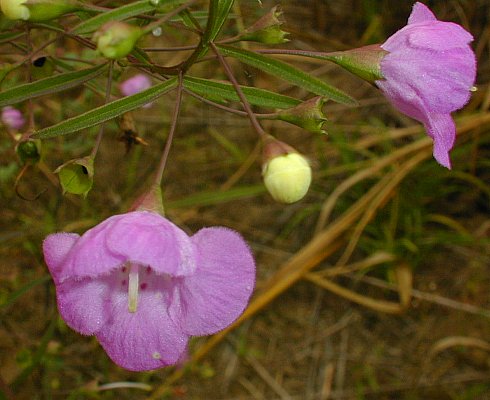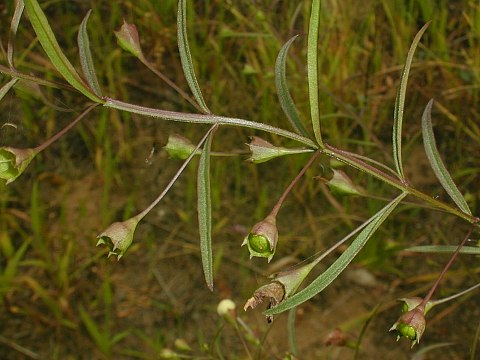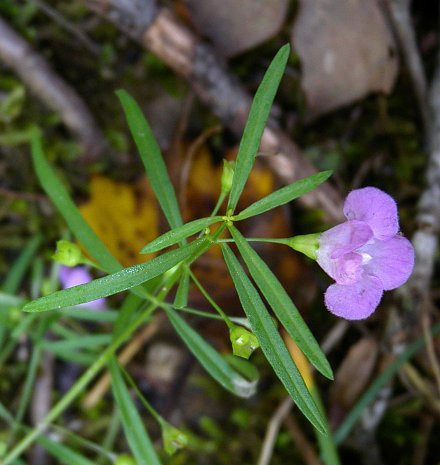Description: This plant is a summer annual about 1-2' tall that usually branches abundantly. It is more or less erect. The slender stems are rather angular with flat ridges, green to reddish purple, and hairless to mostly hairless. The opposite leaves are up to 3" long and 1/8" (3 mm.) across; they are green to purplish/reddish green, linear, glabrous, and sessile. Individual flowers and their buds are produced from the axils of the leaves on the upper and outer stems; these flowering stems can be regarded as leafy racemes. The swollen flower buds are conspicuously white. Each flower is about ½–¾" across, consisting of a short tubular corolla with 5 petal-like lobes and a tubular calyx with 5 short teeth.

The corolla is
pink, purplish pink, or medium purple; its 5 rounded lobes are quite
large in relation to its tubular base. The lobes are finely ciliate
along their margins. The lower interior of the corolla has dark purple
spots and a pair of faint yellow lines. Near the upper interior of the
corolla, there are 4 stamens with hairy white anthers and an undivided
white style (sometimes with a pale yellow tip). The
slender pedicels of
the flowers are green to reddish purple; they are usually as long or
longer than the flowers
(at least ½" long). The blooming
period occurs during the late summer or early fall and lasts about 2-3
weeks. Each flower lasts only a day or two before its corolla falls to
the ground. There is no noticeable floral scent. Each flower is
replaced by a globoid seed capsule containing many small seeds that can
be blown about by the wind. The root system is fibrous. Slender False
Foxglove is partially parasitic on other plants.
Cultivation:
The preference is full or partial sun, moist to slightly dry
conditions, and a rather loose, friable soil containing silt or sand
that is slightly to moderately acidic. This species also adapts to thin
rocky soil. Its growth is more robust when a suitable host plant is
present nearby.

Range &
Habitat:
Slender False Foxglove is occasional throughout Illinois, where it is
native (see Distribution
Map). Habitats
include moist to mesic prairies, sand prairies, savannas, sandy
savannas, woodland borders, sandstone glades, thickets, low sand flats,
silty or sandy roadside ditches, and edges of fields. This species
tends to occur in slightly disturbed habitats with infertile soil and
sparse ground vegetation. It has low fidelity to any particular habitat.
Faunal Associations:
The nectar of the flowers attracts long-tongued bees (bumblebees,
honeybees, and Large Leaf-Cutting bees), Panurgine bees (Calliopsis
andreniformis & others), and butterflies. Some
Halictid bees collect pollen, while Syrphid flies occasionally feed on
the pollen. Large Leaf-Cutting bees (Megachile spp.)
sometimes cut the petals (lobes) of the flowers for nesting material.
Among these various insects, the long-tongued bees and Panurgine bees
are more effective at cross-pollination of the flowers (see Robertson,
1929). The caterpillars of the butterfly Junonia coenia
(Buckeye) feed on the foliage. Mammalian herbivores may browse on the
foliage of Slender False Foxglove, although it is reportedly toxic to
sheep.
Photographic Location:
The edge of a restored sand prairie at Heron Park, Vermilion County,
Illinois, and edge of a rocky wooded bluff at Shades States Park in
west-central Indiana.

Comments: Slender False Foxglove is very showy during the short period in which it is in full bloom. This is the most common and widespread Agalinus sp. in Illinois, probably because it can adapt to a broad range of habitats. There is some variation in the length of the leaves, the presence or absence of fascicled leaves, the size of the flowers, and the color of the flowers across different local populations. Such minor variations have led to the description of different varieties and even different species by some authorities. Generally, Slender False Foxglove differs from many other Agalinus spp. by having flowers with shorter corolla tubes and longer pedicels. In contrast, Agalinus purpureus (Purple False Foxglove) has more elongated flowers (up to 1" long) and shorter pedicels (less than ¼"). Slender False Foxglove also has darker foliage (green to reddish purple) and darker seeds than some Agalinus spp. Members of this latter group (e.g., Agalinus skinneriana) have pale green to yellowish green foliage and pale-colored seeds.